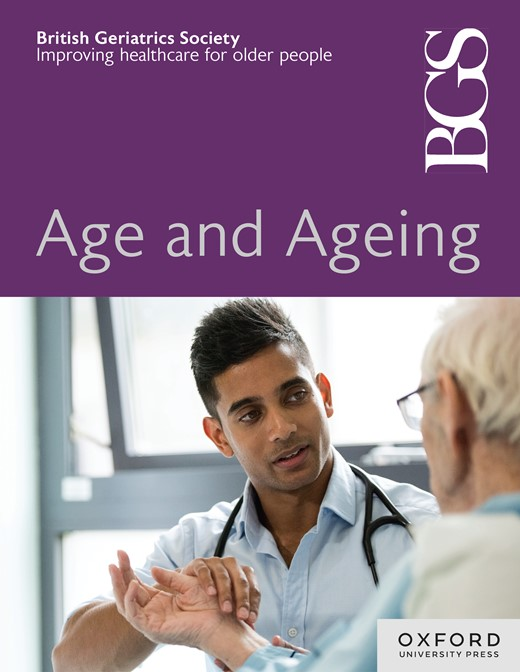Retrospective Review of Falls in Medical Inpatients Following Introduction of a Falls Proforma at Wexford General Hospital
IF 6
2区 医学
Q1 GERIATRICS & GERONTOLOGY
引用次数: 0
Abstract
Background Inpatient falls are the largest category of preventable inpatient adverse events in hospitals coming at both great financial and safety cost to a healthcare system. Approximately 30% of inpatient falls result in injury, 4-6% resulting in serious injury with older patients have the highest risk of falling and injury. The aim of this retrospective audit cycle was to improve standards of falls assessments performed by junior doctors. Methods We initially conducted a retrospective review of 7 medical inpatient falls in July 2023. Standards were compared against NICE Guidelines on Assessment and Prevention of Falls in older people 2013 and NICE guidelines on Assessment and early management of head injury 2023. 15 key elements were analysed: doctor identifier, date and time, history of fall, confusion, pain, loss of consciousness, amnesia, seizure, vomiting, medication review, hip fracture, wrist fracture, skull fracture, Glasgow Coma Scale and neurological deficit. One point was given for each of the 15 key elements noted in the falls review. Following introduction of a falls proforma, we re-audited 18 falls in February 2024 to analyse differences in scores. Results Prior to proforma introduction, 7 falls reviewed had an average score of 3 points. 4 falls were reviewed by SHOs, 1 each by an SpR and Intern and 1 NCHD review was unidentifiable. Mean age was 72. Following proforma introduction, 18 falls in 13 patients were analysed. 2 patients did not have a falls review, 15 were reviewed by SHOs, 1 by an Intern. Average age was 81. Proforma was used in 7 cases with an average score of 12.7, and no proforma was used in 11 cases with an average score of 5. Conclusion These findings demonstrate improved quality of falls reviews using proformas in line with guidelines compared to those without. More education is needed to incorporate proformas into standard practice.韦克斯福德综合医院引入跌倒表格后对住院病人跌倒情况的回顾性审查
背景住院病人跌倒是医院可预防的住院病人不良事件中最大的一类,给医疗系统带来了巨大的经济和安全代价。大约 30% 的住院病人跌倒会导致受伤,4-6% 会导致重伤,而老年病人跌倒和受伤的风险最高。本回顾性审计周期的目的是提高初级医生进行跌倒评估的标准。方法 我们首先对 2023 年 7 月发生的 7 起住院病人跌倒事件进行了回顾性审核。我们将评估标准与 2013 年 NICE 老年人跌倒评估与预防指南和 2023 年 NICE 头部损伤评估与早期管理指南进行了比较。分析了 15 个关键要素:医生标识符、日期和时间、跌倒史、意识模糊、疼痛、意识丧失、健忘、癫痫发作、呕吐、药物复查、髋部骨折、腕部骨折、颅骨骨折、格拉斯哥昏迷量表和神经功能缺损。对跌倒审查中注意到的 15 项关键要素,每项给一分。在引入跌倒评分表后,我们于 2024 年 2 月对 18 起跌倒事件进行了重新审核,以分析评分差异。结果 在引入表格之前,7 例跌倒的平均得分为 3 分。4 例跌倒由护士长审核,1 例由护士长和实习生审核,1 例无法确定是否由国家保健中心审核。平均年龄为 72 岁。在引入表格后,对 13 名患者的 18 次跌倒进行了分析。2 名患者未进行跌倒复查,15 名患者由护士长复查,1 名患者由实习医生复查。平均年龄为 81 岁。7 例使用了预案,平均得分 12.7 分,11 例未使用预案,平均得分 5 分。结论 这些研究结果表明,与未使用表格的病例相比,使用符合指南要求的表格进行跌倒复查的质量有所提高。需要开展更多的教育,将表格纳入标准实践。
本文章由计算机程序翻译,如有差异,请以英文原文为准。
求助全文
约1分钟内获得全文
求助全文
来源期刊

Age and ageing
医学-老年医学
CiteScore
9.20
自引率
6.00%
发文量
796
审稿时长
4-8 weeks
期刊介绍:
Age and Ageing is an international journal publishing refereed original articles and commissioned reviews on geriatric medicine and gerontology. Its range includes research on ageing and clinical, epidemiological, and psychological aspects of later life.
 求助内容:
求助内容: 应助结果提醒方式:
应助结果提醒方式:


